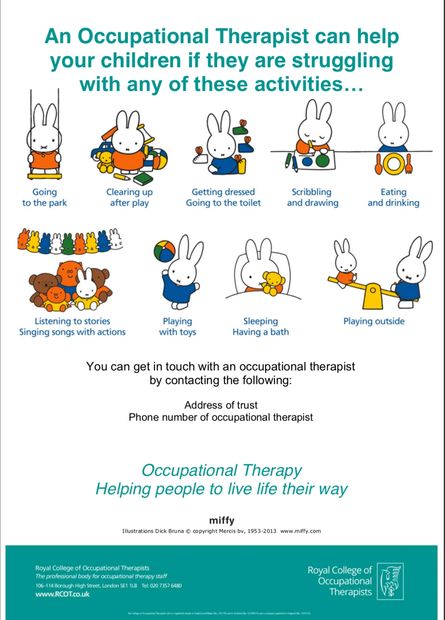
Occupational therapy????
What is occupational therapy?
‘Occupational therapy is a person-centred profession concerned with promoting a balanced range of occupations to enhance health and wellbeing. Occupations refer to everything people do in the course of their daily life.
Occupational therapists believe that everyone has the right to the opportunity to fulfil their potential’ (COT, 2015).
‘Occupational therapists will spend time finding out about the child’s and family’s typical daily life and what they want, need or are expected to do. They will then work together with the child, family and other key people to evaluate what helps or hinders their involvement in daily life roles. Together, possible solutions will be developed, such as exploring alternative ways of doing things or making changes to the environment to support participation’ (COT, 2015).
Reference
(2015) Occupational Therapy evidence – Fact Sheet: Occupational Therapy and Young People. College Of Occupational Therapists.
Skills for the job of life
What is occupational therapy??
The purpose of occupational therapy is to support children and adults to engage with activity. Through doing this, it will have a positive impact on their independence, health and wellbeing. We want children and adults to build on their skills for life which they can take them into adulthood and beyond.
Skills for life which have a positive impact on the above include (there is much more!):
- Dressing,
- Eating,
- Using the toilet,
- Bathing,
- Following routines for employment, voluntary services, school or nursery,
- Playing with friends,
- Doing sports and/or being interested in hobbies.
Butterflies Holistic Occupational Therapy Leeds can work with children who may be having difficulties with the above which is having a negative impact on their wellbeing. With children, goal setting and 1:1 therapy is based around the child's interests to ensure they are engaged throughout and get the most out of their time with us.

Children's occupational therapy

Miffy and Children's occupational therapy
Miffy gives a very clear idea of how children's occupational therapy can help children to meet their full potential.
Please contact the team if you feel that your child could do with some extra support with;
- Motor skills and fine motor skills including handwriting as well as visual perceptual skills, sensory skills and sensory difficulties.
- Facilitating independence in self care, e.g., dressing, toileting, washing and mealtimes.
- A neurological condition which requires a Maes Therapy approach.
We are based within and around Leeds.
Goal Attainment Scaling (GAS)

Butterflies Holistic Occupational Therapy uses GAS as a method of scoring the extent to which individual goals are achieved in the course of intervention. In short, the process is split into the following 5 sections:
1) Identify your goals
2) Weight the goals - importance and difficulty
3) Define the expected outcome
4) Score the baseline
5) Review during and following intervention
Butterflies Occupational Therapy Blog
Get ready to jump, run and laugh!
Fun but competitive game to improve hand-eye coordination
This is our latest video as part of the Your Questions Answered series.
This month we are focusing on how you can help your child improve their hand-eye coordination with this fun but competitive game.
If you have a question that you want our OT to answer, drop a comment and we will try and answer it in next month's video.